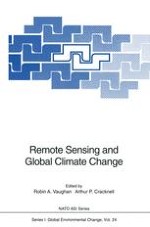1994 | OriginalPaper | Chapter
A Second-Order Two-Scale Model for Rough Surface Scattering with Applications to Scatterometry
Authors : N. I. Nickolaev, M. A. Michalev
Published in: Remote Sensing and Global Climate Change
Publisher: Springer Berlin Heidelberg
Included in: Professional Book Archive
Activate our intelligent search to find suitable subject content or patents.
Select sections of text to find matching patents with Artificial Intelligence. powered by
Select sections of text to find additional relevant content using AI-assisted search. powered by
Scatterometry is a powerful method for studying the dynamics of the ocean-atmosphere interactions. It is based on the fact that the normalised backscattering radar cross section (NBRCS) σ° is sensitive to the surface friction velocity (Jones and Schroeder 1978). The algorithms used to retrieve the surface wind speed are based on empirical models of the microwave scattering signatures derived from experimental data acquired under different atmospheric conditions. The physical mechanisms of the interaction between the microwaves and the sea surface have been the subject of active study for many years but no a theory which explains completely the microwave scattering properties of the sea-atmosphere interface has yet been proposed. The so-called two-scale model (TSM) is still the most widely accepted theoretical treatment of radar backscattering from the sea surface measured at small and moderate incidence angles (Ulaby et al. 1982).
